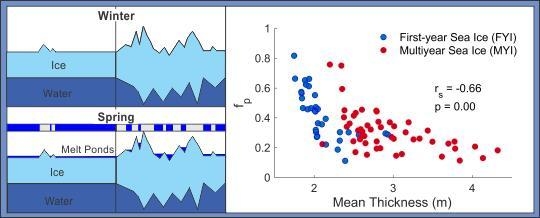Linking Regional Winter Sea Ice Thickness and Surface Roughness to Spring Melt Pond Fraction on Landfast Arctic Sea Ice
Abstract
:1. Introduction
2. Materials and Methods
2.1. Study Area
2.2. Data and Pre-Processing
2.3. Object Based, Hybrid and Grid-Cell Image Analysis
3. Results
3.1. Victoria Strait Thickness, Roughness and fp Distributions in 2015
3.2. Relationship between Thickness and fp
3.3. Relationship between Roughness and fp
3.4. Relationship between Smoothed Surface Roughness and fp
3.5. Relationship between Thickness and Roughness
4. Discussion
5. Conclusions
Acknowledgments
Author Contributions
Conflicts of Interest
References
- Rigor, I.G.; Wallace, J.M. Variations in the age of Arctic sea-ice and summer sea-ice extent. Geophys. Res. Lett. 2004, 31, 2–5. [Google Scholar] [CrossRef]
- Kwok, R.; Cunningham, G.F.; Wensnahan, M.; Rigor, I.; Zwally, H.J.; Yi, D. Thinning and volume loss of the Arctic Ocean sea ice cover: 2003–2008. J. Geophys. Res. 2009, 114. [Google Scholar] [CrossRef]
- Meier, W. Actic sea ice in tranformation: A review of recent observed changes and impacts on biology. Rev. Geophys. 2015, 53, 1–33. [Google Scholar] [CrossRef]
- Swart, N.C.; Fyfe, J.C.; Hawkins, E.; Kay, J.E.; Jahn, A. Influence of internal variability on Arctic sea-ice trends. Nat. Clim. Chang. 2015, 5, 86–89. [Google Scholar] [CrossRef]
- Hanesiak, J.M.; Barber, D.G.; De Abreu, R.A.; Yackel, J.J. Local and regional albedo observations of arctic first-year sea ice during melt ponding. J. Geophys. Res. 2001, 106, 1005–1016. [Google Scholar] [CrossRef]
- Perovich, D.K.; Polashenski, C. Albedo evolution of seasonal Arctic sea ice. Geophys. Res. Lett. 2012, 39, 1–6. [Google Scholar] [CrossRef]
- Perovich, D.K.; Grenfell, T.C.; Light, B.; Hobbs, P.V. Seasonal evolution of the albedo of multiyear Arctic sea ice. J. Geophys. Res. 2002, 107. [Google Scholar] [CrossRef]
- Arrigo, K.R.; Perovich, D.K.; Pickart, R.S.; Brown, Z.W.; van Dijken, G.L.; Lowry, K.E.; Mills, M.M.; Palmer, M.A.; Balch, W.M.; Bahr, F.; et al. Massive Phytoplankton Blooms Under Arctic Sea Ice. Science 2012, 336, 1408. [Google Scholar] [CrossRef] [PubMed]
- Pućko, M.; Stern, G.A.; Macdonald, R.W.; Jantunen, L.M.; Bidleman, T.F.; Wong, F.; Barber, D.G.; Rysgaard, S. The delivery of organic contaminants to the Arctic food web: Why sea ice matters. Sci. Total Environ. 2015, 506–507, 444–452. [Google Scholar] [CrossRef] [PubMed]
- Schröder, D.; Feltham, D.L.; Flocco, D.; Tsamados, M. September Arctic sea-ice minimum predicted by spring melt-pond fraction. Nat. Clim. Chang. 2014, 4, 353–357. [Google Scholar] [CrossRef]
- Eicken, H.; Grenfell, T.C.; Perovich, D.K.; Richter-Menge, J.A.; Frey, K. Hydraulic controls of summer Arctic pack ice albedo. J. Geophys. Res. Oceans 2004, 109, 1–13. [Google Scholar] [CrossRef]
- Eicken, H. Tracer studies of pathways and rates of meltwater transport through Arctic summer sea ice. J. Geophys. Res. 2002, 107, 1–20. [Google Scholar] [CrossRef]
- Polashenski, C.; Perovich, D.; Courville, Z. The mechanisms of sea ice melt pond formation and evolution. J. Geophys. Res. 2012, 117, 1–23. [Google Scholar] [CrossRef]
- Rösel, A.; Kaleschke, L.; Birnbaum, G. Melt ponds on Arctic sea ice determined from MODIS satellite data using an artificial neural network. Cryosphere 2012, 6, 431–446. [Google Scholar] [CrossRef] [Green Version]
- Scharien, R.K.; Hochheim, K.; Landy, J.; Barber, D.G. First-year sea ice melt pond fraction estimation from dual-polarisation C-band SAR – Part 2: Scaling in situ to Radarsat-2. Cryosphere 2014, 8, 2163–2176. [Google Scholar] [CrossRef]
- Han, H.; Im, J.; Kim, M.; Sim, S.; Kim, J.; Kim, D.J.; Kang, S.H. Retrieval of melt ponds on arctic multiyear sea ice in summer from TerraSAR-X dual-polarization data using machine learning approaches: A case study in the Chukchi Sea with mid-incidence angle data. Remote Sens. 2016, 8, 57. [Google Scholar] [CrossRef]
- Kettig, R.L.; Landgrebe, D.A. Classification of Multispectral Image Data by Extraction and Classification of Homogeneous Objects Classification of Multispectral Image Data by Extraction and Classification of Homogeneous Objects. IEEE Trans. Geosci. Electron. 1976, 14, 19–26. [Google Scholar] [CrossRef]
- Blaschke, T. Object based image analysis for remote sensing. ISPRS J. Photogramm. Remote Sens. 2010, 65, 2–16. [Google Scholar] [CrossRef]
- Hay, G.; Marceau, D.; Dube, P.; Bouchard, A. A Multiscale Framework for Landscape Analysis: Object-specific analysis and upscaling. Landscape 2001, 16, 471–490. [Google Scholar]
- Mazur, A.K.; Wåhlin, A.K.; Krężel, A. An object-based SAR image iceberg detection algorithm applied to the Amundsen Sea. Remote Sens. Environ. 2017, 189, 67–83. [Google Scholar] [CrossRef]
- Canadian Ice Service. Sea Ice Climatic Atlas: Northern Canadian Water 1981-2010; Environment Canada: Ottawa, ON, Canada, 2007.
- Melling, H. Sea ice of the northern Canadian Arctic Archipelago. J. Geophys. Res. Ocean. 2002, 107. [Google Scholar] [CrossRef]
- Howell, S.E.L.; Wohlleben, T.; Dabboor, M.; Derksen, C.; Komarov, A.; Pizzolato, L. Recent changes in the exchange of sea ice between the Arctic Ocean and the Canadian Arctic Archipelago. J. Geophys. Res. Oceans 2013, 118, 3595–3607. [Google Scholar] [CrossRef]
- Haas, C.; Howell, S.E.L. Ice thickness in the Northwest Passage. Geophys. Res. Lett. 2015, 1–8. [Google Scholar] [CrossRef]
- Haas, C.; Lobach, J.; Hendricks, S.; Rabenstein, L.; Pfaf, A. Helicopter-borne measurements of sea ice thickness, using a small and lightweight, digital EM system. J. Appl. Geophys. 2009, 67, 234–241. [Google Scholar] [CrossRef] [Green Version]
- Beckers, J.F.; Renner, A.H.H.; Spreen, G.; Gerland, S.; Haas, C. Sea-ice surface roughness estimates from airborne laser scanner and laser altimeter observations in Fram Strait and north of Svalbard. Ann. Glaciol. 2015, 56, 235–244. [Google Scholar] [CrossRef]
- Sarp, G. Spectral and spatial quality analysis of pan-sharpening algorithms: A case study in Istanbul. Eur. J. Remote Sens. 2014, 47, 19–28. [Google Scholar] [CrossRef]
- Flanders, D.; Hall-Beyer, M.; Pereverzoff, J. Preliminary evaluation of eCognition object-based software for cut block delineation and feature extraction. Can. J. Remote Sens. 2003, 29, 441–452. [Google Scholar] [CrossRef]
- Bunting, P.; Lucas, R. The delineation of tree crowns in Australian mixed species forests using hyperspectral Compact Airborne Spectrographic Imager (CASI) data. Remote Sens. Environ. 2006, 101, 230–248. [Google Scholar] [CrossRef]
- Duro, D.C.; Franklin, S.E.; Dubé, M.G. A comparison of pixel-based and object-based image analysis with selected machine learning algorithms for the classification of agricultural landscapes using SPOT-5 HRG imagery. Remote Sens. Environ. 2012, 118, 259–272. [Google Scholar] [CrossRef]
- Robson, M.; Secker, J.; Vachon, P.W. Evaluation of eCognition for assisted target detection and recognition in SAR imagery. Int. Geosci. Remote Sens. Symp. 2006, 145–148. [Google Scholar] [CrossRef]
- Scharien, R.K.; Yackel, J.J.; Granskog, M.A.; Else, B.G.T. Coincident high resolution optical-SAR image analysis for surface albedo estimation of first-year sea ice during summer melt. Remote Sens. Environ. 2007, 111, 160–171. [Google Scholar] [CrossRef]
- Benz, U.C.; Hofmann, P.; Willhauck, G.; Lingenfelder, I.; Heynen, M. Multi-resolution, object-oriented fuzzy analysis of remote sensing data for GIS-ready information. ISPRS J. Photogramm. Remote Sens. 2004, 58, 239–258. [Google Scholar] [CrossRef]
- Fetterer, F.; Untersteiner, N. Observations of melt ponds on Arctic sea ice. J. Geophys. Res. 2000, 103. [Google Scholar] [CrossRef]
- Webster, M.A.; Rigor, I.G.; Perovich, D.K.; Richter-menge, J. A.; Polashenski, C.M.; Light, B. Seasonal evolution of melt ponds on Arctic sea ice. J. Geophys. Res. 2015, 120, 5968–5982. [Google Scholar] [CrossRef]
- Landy, J.C.; Ehn, J.K.; Barber, D.G. Albedo feedback enhanced by smoother Arctic sea ice. Geophys. Res. Lett. 2015, 42, 10714–10720. [Google Scholar] [CrossRef]
- Perovich, D.K. The Optical Properties of Sea Ice; PN: Arlington, VA, USA, 1996. [Google Scholar]
- Mahoney, A.; Eicken, H.; Gaylord, A.G.; Shapiro, L. Alaska landfast sea ice: Links with bathymetry and atmospheric circulation. J. Geophys. Res. 2007, 112. [Google Scholar] [CrossRef]
- Grenfell, T.C.; Perovich, D.K. Seasonal and spatial evolution of albedo in a snow-ice-land-ocean environment. J. Geophys. Res. 2004, 109. [Google Scholar] [CrossRef]
- King, J.; Howell, S.; Derksen, C.; Rutter, N.; Toose, P.; Beckers, J.F.; Haas, C.; Kurtz, N.; Richter-Menge, J. Evaluation of Operation IceBridge quick-look snow depth estimates on sea ice. Geophys. Res. Lett. 2015, 42, 9302–9310. [Google Scholar] [CrossRef]
- Howell, S.E.L.; Laliberté, F.; Kwok, R.; Derksen, C.; King, J. Landfast ice thickness in the Canadian Arctic Archipelago from Observations and Models. Cryosph. Discuss. 2016, 1–39. [Google Scholar] [CrossRef]
- Bogsjö, K.; Podgórski, K.; Rychlik, I. Models for road surface roughness. Veh. Syst. Dyn. 2012, 50, 725–747. [Google Scholar] [CrossRef]
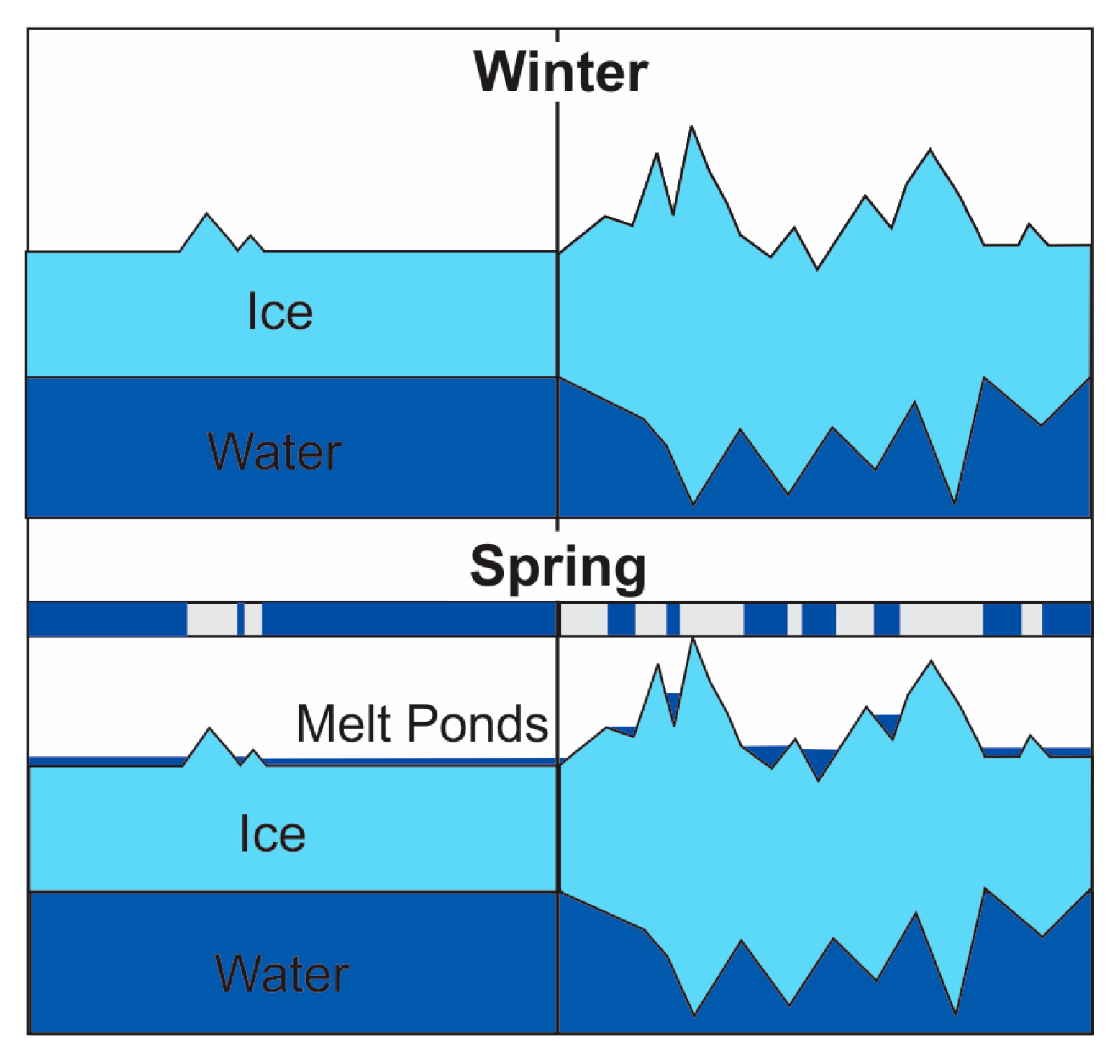

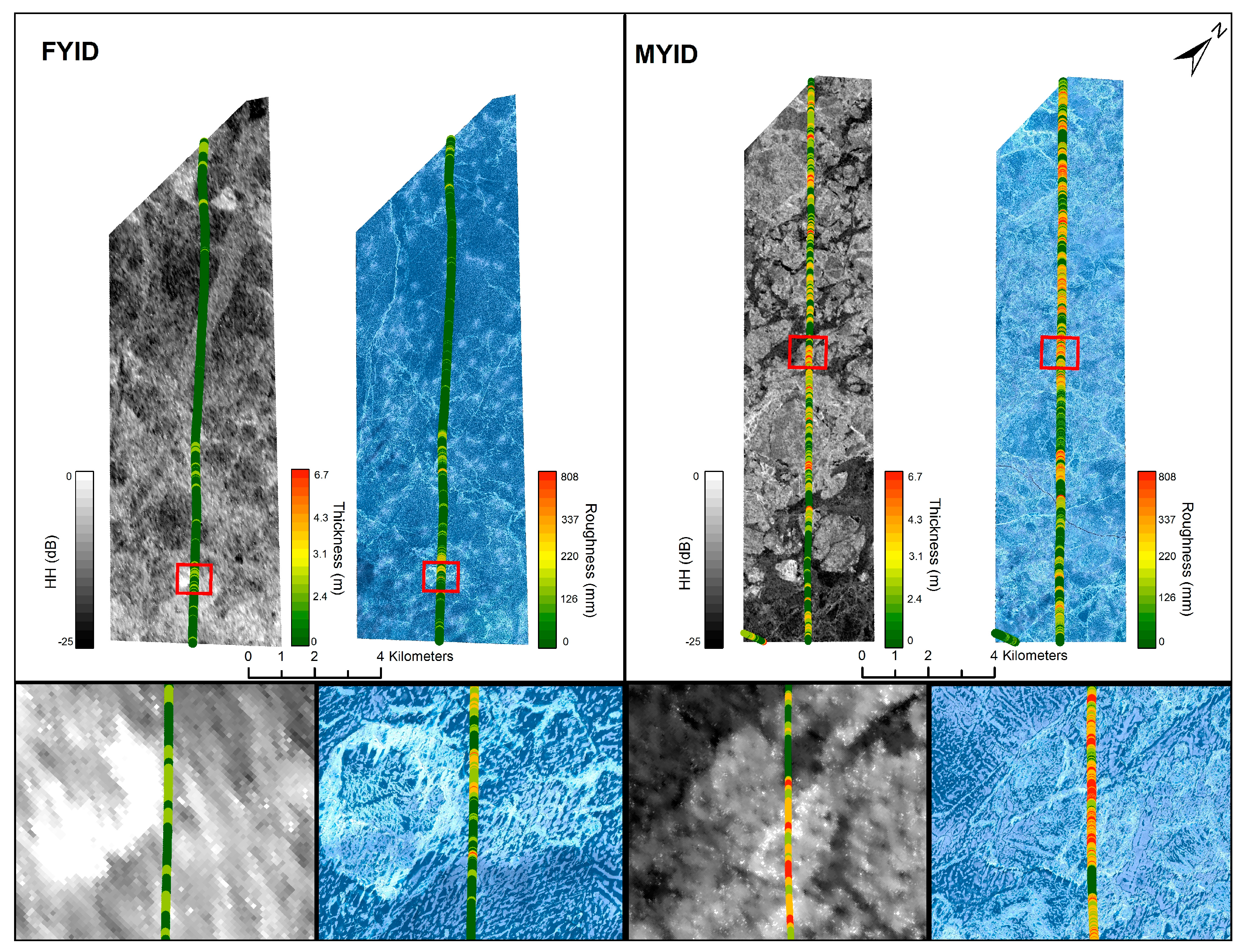
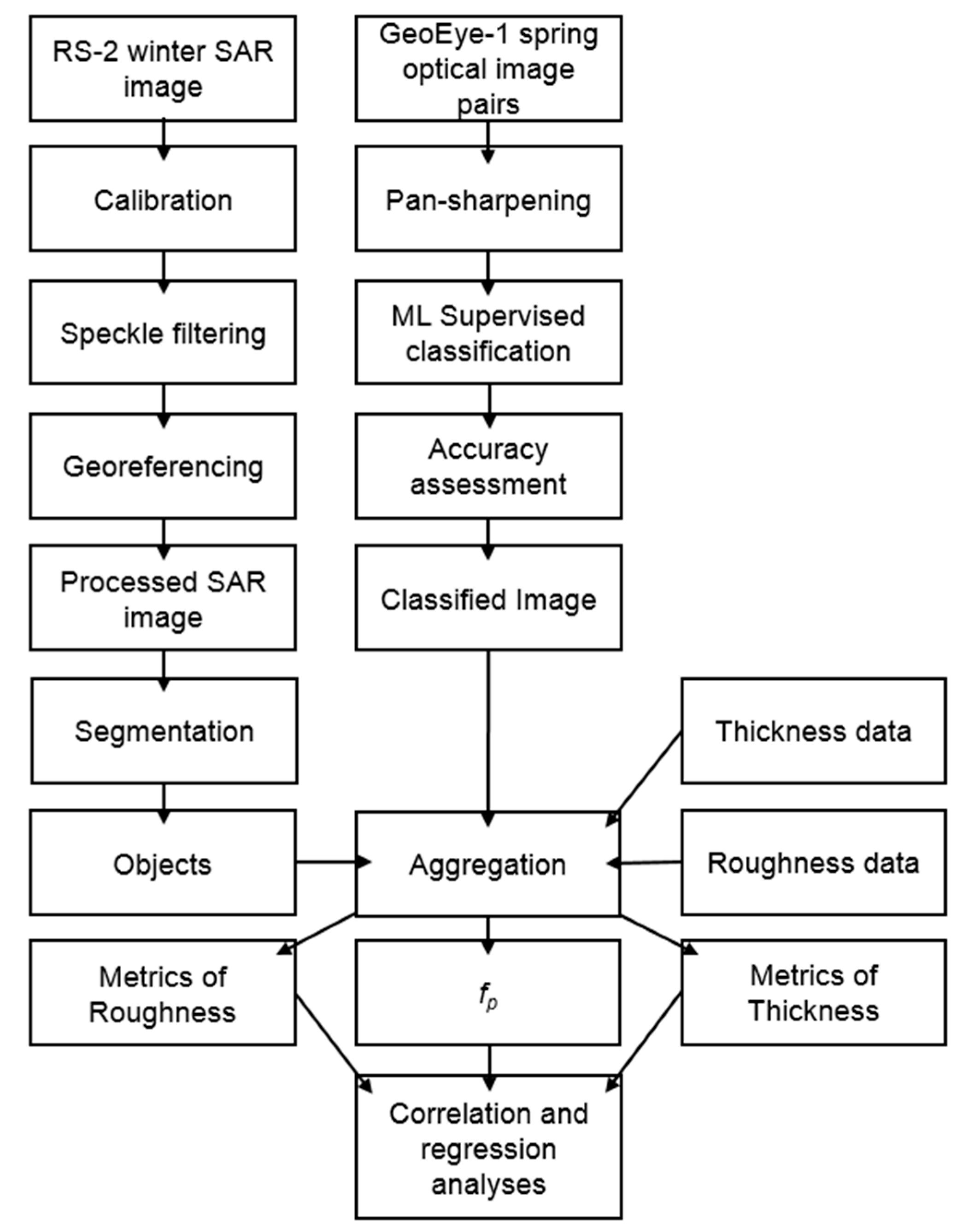

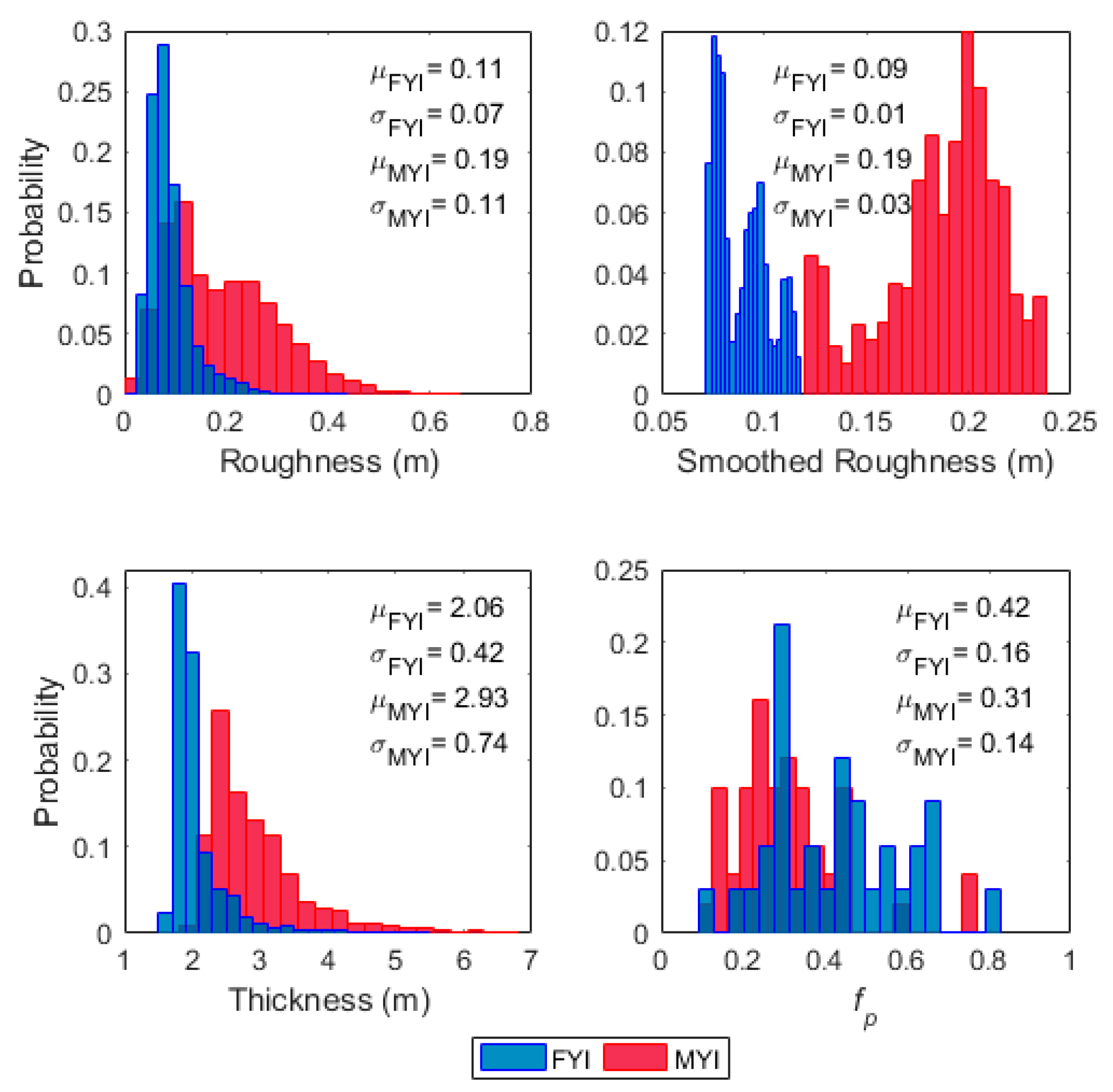

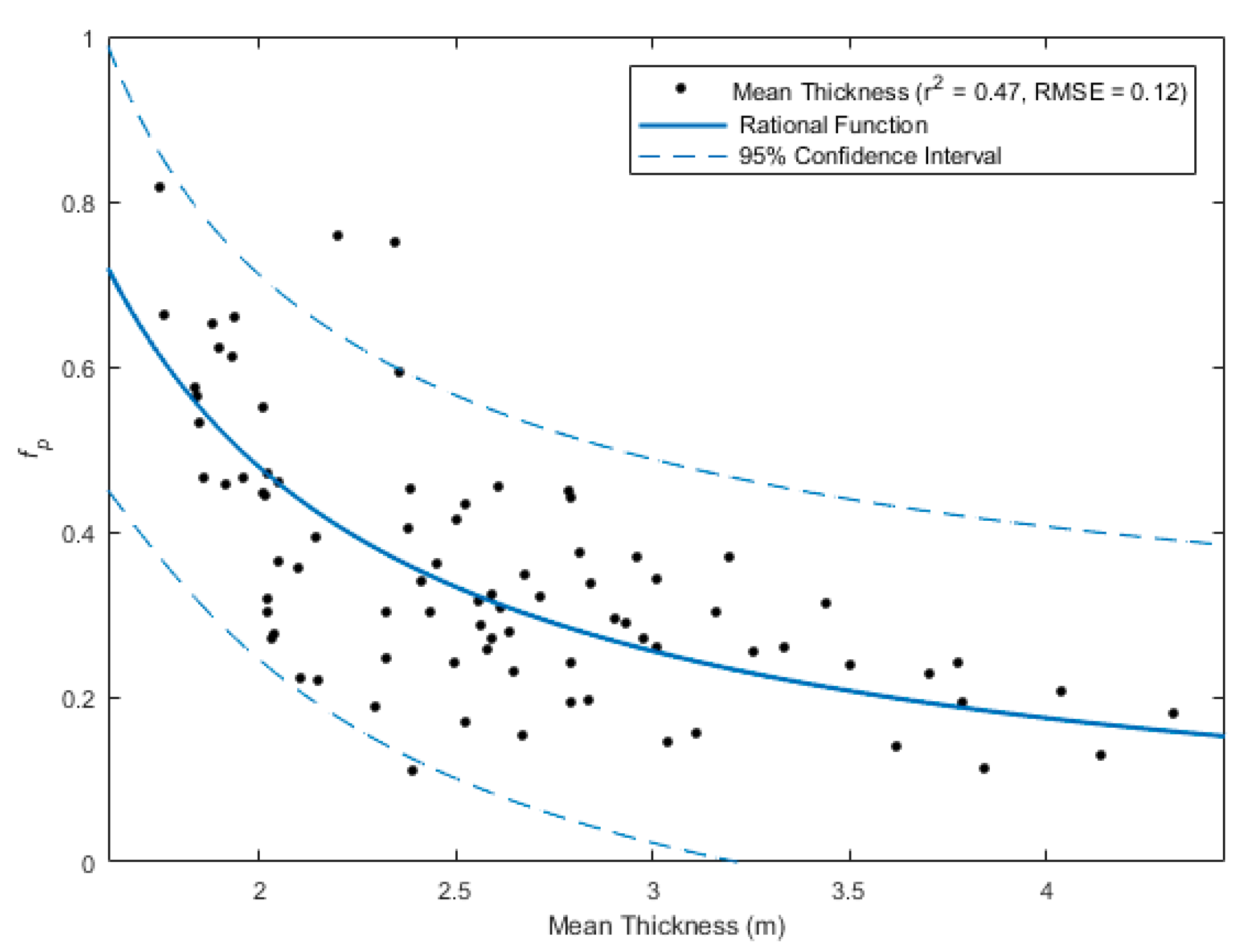

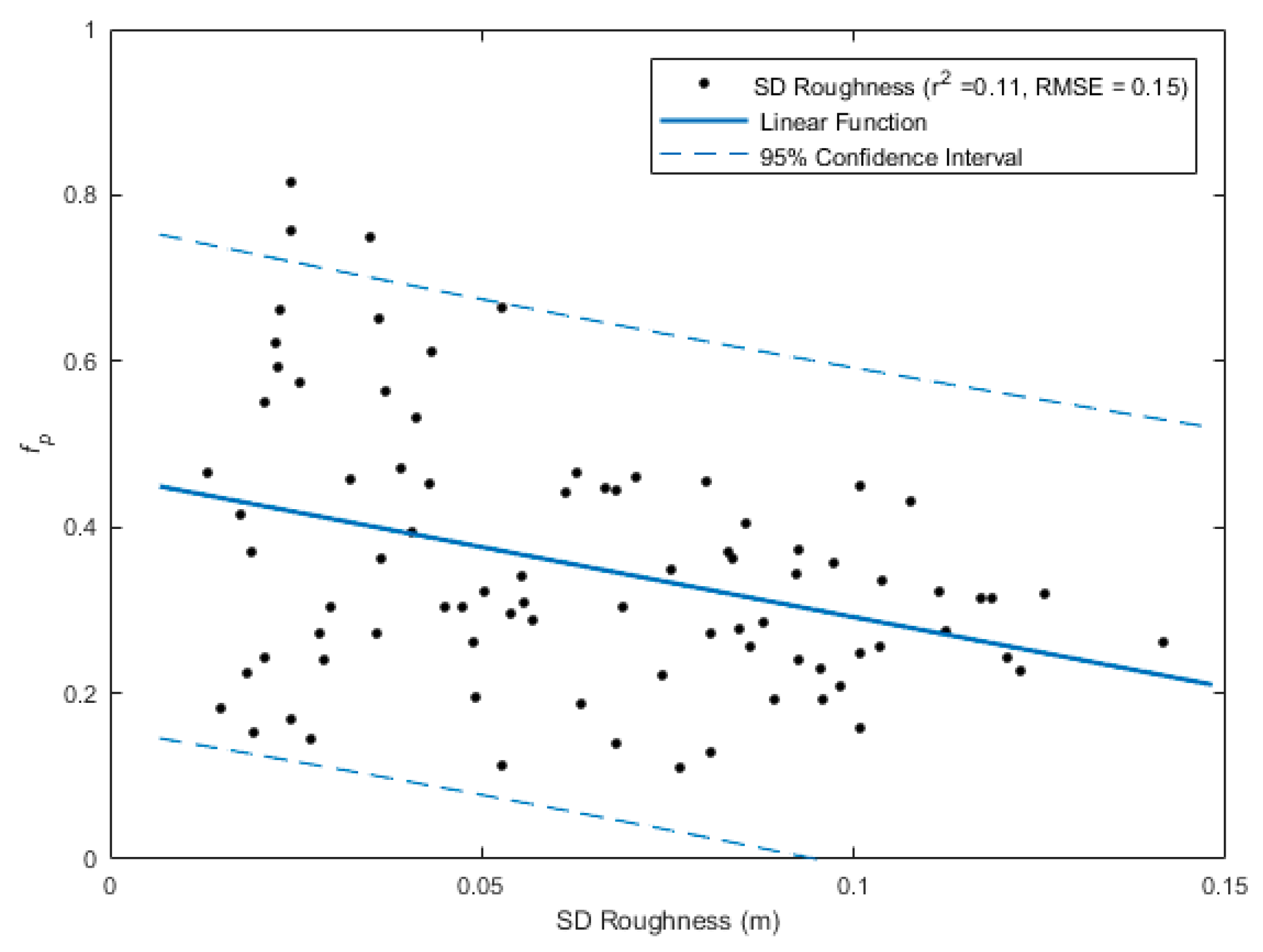

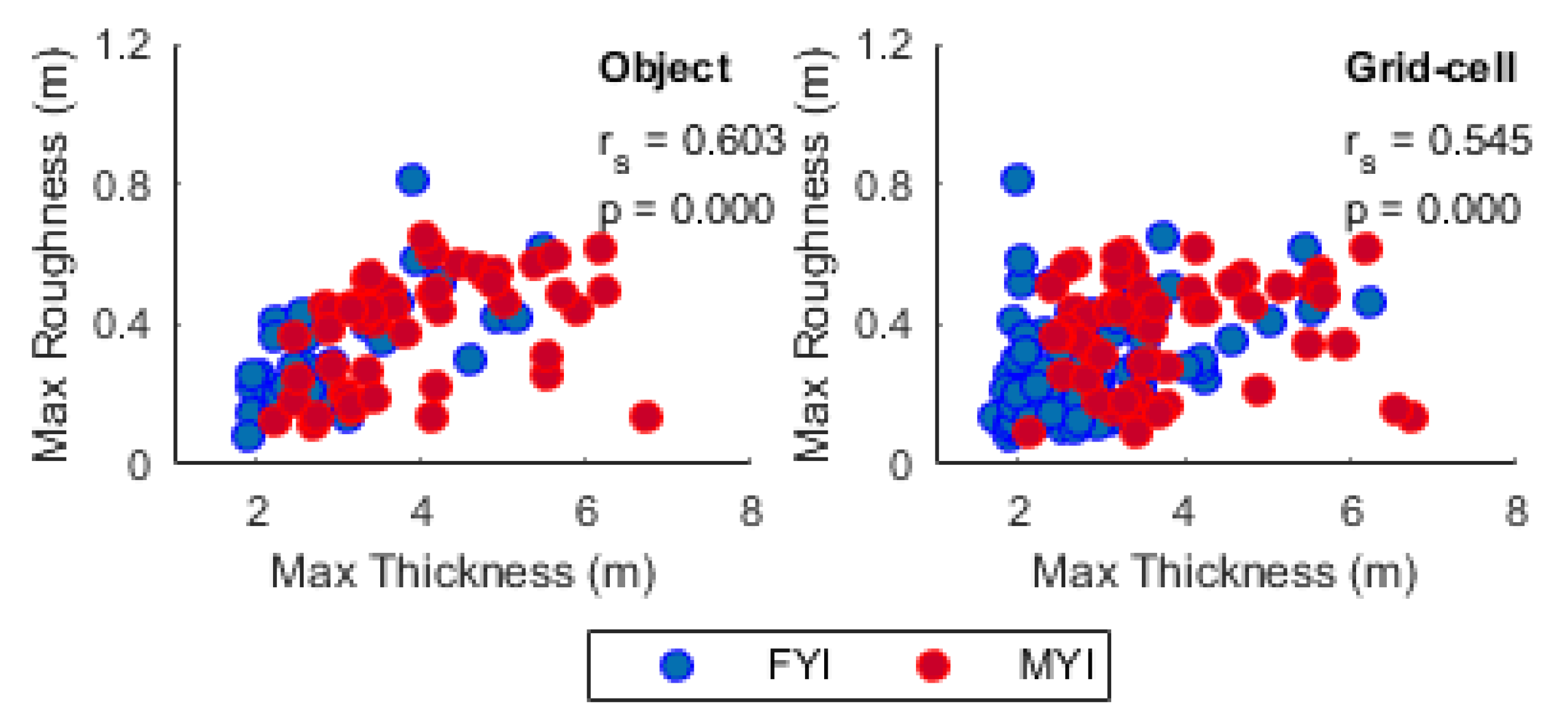
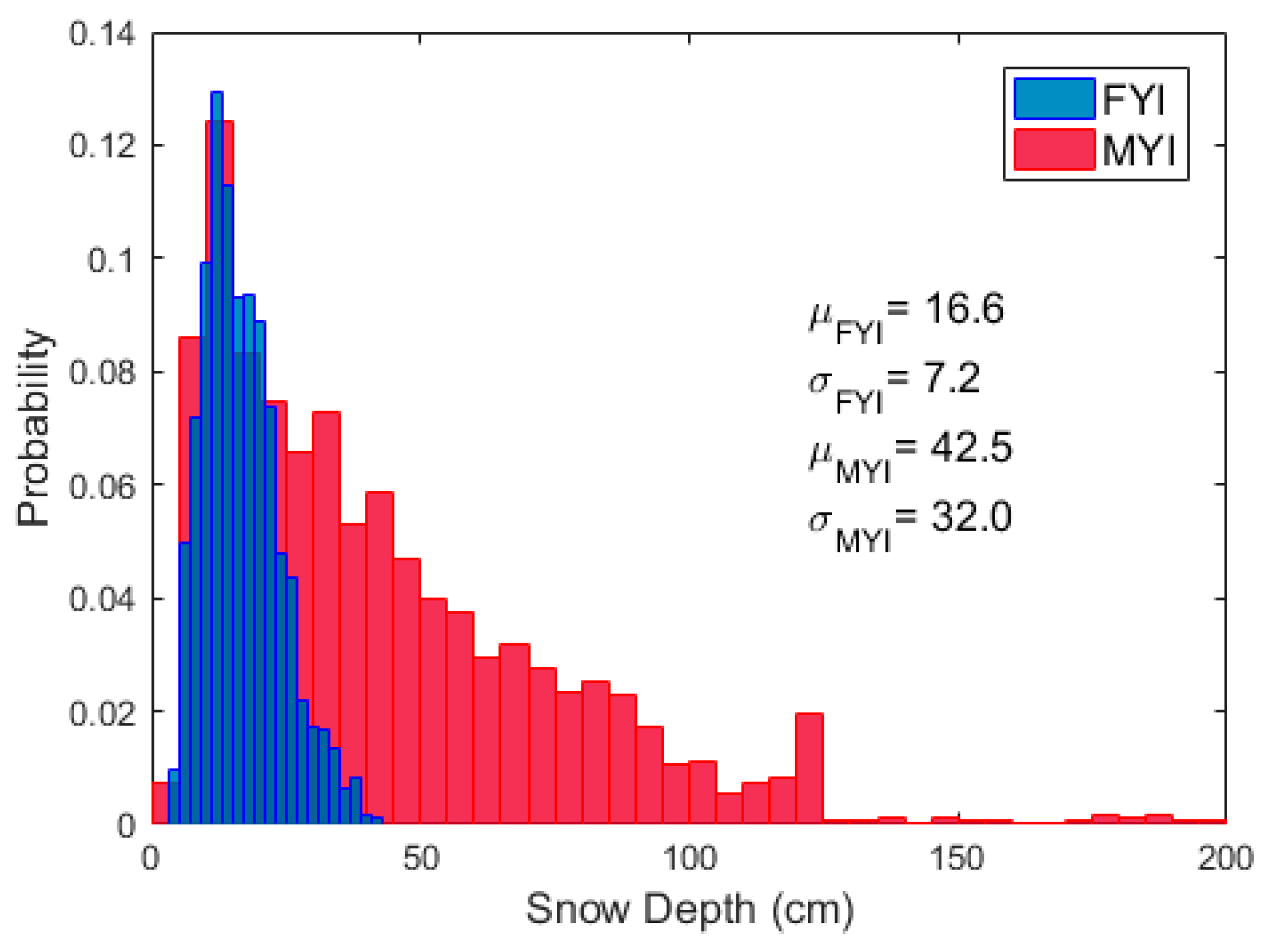
| Parameter | Instrument | Measurement Approach | Platform | Acquisition Dates | Description |
|---|---|---|---|---|---|
| Snow plus Ice Thickness | EM-bird | Electromagnetic induction and laser altimeter | Airborne | 19 April 2015 | Spatial resolution: 6.0 m Swath width: ~120 m Accuracy: 0.15 m |
| Ice Surface Roughness | Riegel Laser Measurement System Q120 | 2D laser scanner | Airborne | 19 April 2015 | Spatial resolution: 1.2 m Swath width: 105 m Accuracy: 0.025 m |
| Melt Pond Fraction (fp) | GeoEye-1 | Multispectral (VIS/NIR) | Satellite | 22 June 2015 23 June 2015 25 June 2015 | Spatial resolution: Panchromatic (0.5 m), Multispectral (2.0 m) Spectral resolution: RGBNIR |
| Objects | RADARSAT-2 | C-band frequency SAR | Satellite | 23 April 2015 25 April 2015 | 23 April 2015 Pixel Spacing (azimuth × range): 5.1 × 4.7 m Incidence angle: 40.2°–41.6° Polarization: Fine Quad 25 April 2015 Pixel spacing (azimuth × range): 4.9 × 4.7 m Incidence angle: 22.3°–24.2° Polarization: Fine Quad |
| FYI | MYI | FYI | MYI | FYI | MYI | ||||||||||||
|---|---|---|---|---|---|---|---|---|---|---|---|---|---|---|---|---|---|
| Fine | Med | Fine | Med | Coarse | Fine | Med | Fine | Med | Coarse | 120 m | 240 m | 120 m | 240 m | ||||
| Min | Objects | −0.66 | −0.61 | −0.37 | −0.33 | −0.31 | Hybrid | −0.64 | −0.67 | −0.32 | −0.27 | −0.31 | Grid-cell | −0.61 | −0.65 | −0.30 | −0.11 |
| Max | −0.51 | −0.67 | −0.45 | −0.33 | −0.29 | −0.40 | −0.73 | −0.43 | −0.42 | −0.40 | −0.72 | −0.75 | −0.46 | −0.38 | |||
| Mean | −0.72 | −0.75 | −0.59 | −0.54 | −0.56 | −0.68 | −0.85 | −0.55 | −0.56 | −0.59 | −0.71 | −0.75 | −0.47 | −0.41 | |||
| Med | −0.75 | −0.71 | −0.60 | −0.56 | −0.58 | −0.74 | −0.81 | −0.59 | −0.60 | −0.64 | −0.69 | −0.75 | −0.45 | −0.44 | |||
| SD | −0.38 | −0.65 | −0.36 | −0.25 | −0.25 | −0.31 | −0.72 | −0.32 | −0.32 | −0.34 | −0.60 | −0.69 | −0.47 | −0.38 | |||
| FYI | MYI | FYI | MYI | FYI | MYI | ||||||||||||
|---|---|---|---|---|---|---|---|---|---|---|---|---|---|---|---|---|---|
| Fine | Med | Fine | Med | Coarse | Fine | Med | Fine | Med | Coarse | 120 m | 240 m | 120 m | 240 m | ||||
| Min | Objects | −0.34 | −0.32 | 0.30 | 0.21 | 0.16 | Hybrid | −0.35 | −0.31 | 0.25 | 0.27 | 0.19 | Grid-cell | −0.25 | −0.26 | −0.05 | −0.01 |
| Max | −0.29 | −0.57 | 0.01 | 0.05 | 0.07 | −0.20 | −0.53 | 0.02 | 0.04 | 0.01 | −0.40 | −0.55 | −0.10 | −0.12 | |||
| Mean | −0.32 | −0.53 | 0.02 | 0.03 | −0.02 | −0.25 | −0.52 | 0.04 | 0.09 | 0.00 | −0.35 | −0.42 | −0.09 | −0.11 | |||
| Med | −0.22 | −0.41 | −0.03 | 0.00 | −0.07 | −0.14 | −0.36 | 0.03 | 0.06 | −0.03 | −0.30 | −0.37 | −0.07 | −0.11 | |||
| SD | −0.35 | −0.59 | −0.07 | −0.03 | −0.02 | −0.29 | −0.63 | 0.00 | −0.01 | −0.06 | −0.39 | −0.54 | −0.10 | −0.17 | |||
| FYI | MYI | FYI | MYI | FYI | MYI | ||||||||||||
|---|---|---|---|---|---|---|---|---|---|---|---|---|---|---|---|---|---|
| Fine | Med | Fine | Med | Coarse | Fine | Med | Fine | Med | Coarse | 120 m | 240 m | 120 m | 240 m | ||||
| Min | Objects | −0.81 | −0.80 | −0.31 | −0.35 | −0.34 | Hybrid | −0.77 | −0.84 | −0.34 | −0.29 | −0.25 | Grid-cell | −0.72 | −0.77 | −0.20 | −0.23 |
| Max | −0.79 | −0.81 | −0.27 | −0.26 | −0.21 | −0.72 | −0.80 | −0.24 | −0.19 | −0.09 | −0.72 | −0.77 | −0.19 | −0.22 | |||
| Mean | −0.80 | −0.81 | −0.29 | −0.29 | −0.27 | −0.75 | −0.83 | −0.28 | −0.23 | −0.17 | −0.72 | −0.77 | −0.19 | −0.22 | |||
| Med | −0.80 | −0.81 | −0.29 | −0.29 | −0.26 | −0.75 | −0.82 | −0.26 | −0.22 | −0.16 | −0.72 | −0.77 | −0.19 | −0.22 | |||
| SD | −0.14 | −0.34 | 0.06 | 0.24 | 0.28 | −0.04 | −0.23 | 0.17 | 0.19 | 0.26 | −0.45 | −0.55 | 0.08 | 0.01 | |||
| FYI | MYI | FYI | MYI | ||||||||
|---|---|---|---|---|---|---|---|---|---|---|---|
| Fine | Med | Fine | Med | Coarse | 120 m | 240 m | 120 m | 240 m | |||
| Min | Objects | 0.39 | 0.36 | 0.07 | 0.21 | 0.27 | Grid-cell | 0.30 | 0.34 | 0.01 | 0.23 |
| Max | 0.56 | 0.65 | 0.41 | 0.54 | 0.57 | 0.44 | 0.53 | 0.11 | 0.13 | ||
| Mean | 0.36 | 0.49 | 0.20 | 0.20 | 0.23 | 0.41 | 0.44 | 0.07 | 0.07 | ||
| Med | 0.18 | 0.26 | 0.12 | 0.06 | 0.03 | 0.34 | 0.38 | 0.04 | 0.13 | ||
| SD | 0.52 | 0.68 | 0.40 | 0.47 | 0.47 | 0.35 | 0.45 | 0.05 | 0.07 | ||
© 2017 by the authors. Licensee MDPI, Basel, Switzerland. This article is an open access article distributed under the terms and conditions of the Creative Commons Attribution (CC BY) license (http://creativecommons.org/licenses/by/4.0/).
Share and Cite
Nasonova, S.; Scharien, R.K.; Haas, C.; Howell, S.E.L. Linking Regional Winter Sea Ice Thickness and Surface Roughness to Spring Melt Pond Fraction on Landfast Arctic Sea Ice. Remote Sens. 2018, 10, 37. https://doi.org/10.3390/rs10010037
Nasonova S, Scharien RK, Haas C, Howell SEL. Linking Regional Winter Sea Ice Thickness and Surface Roughness to Spring Melt Pond Fraction on Landfast Arctic Sea Ice. Remote Sensing. 2018; 10(1):37. https://doi.org/10.3390/rs10010037
Chicago/Turabian StyleNasonova, Sasha, Randall K. Scharien, Christian Haas, and Stephen E. L. Howell. 2018. "Linking Regional Winter Sea Ice Thickness and Surface Roughness to Spring Melt Pond Fraction on Landfast Arctic Sea Ice" Remote Sensing 10, no. 1: 37. https://doi.org/10.3390/rs10010037




